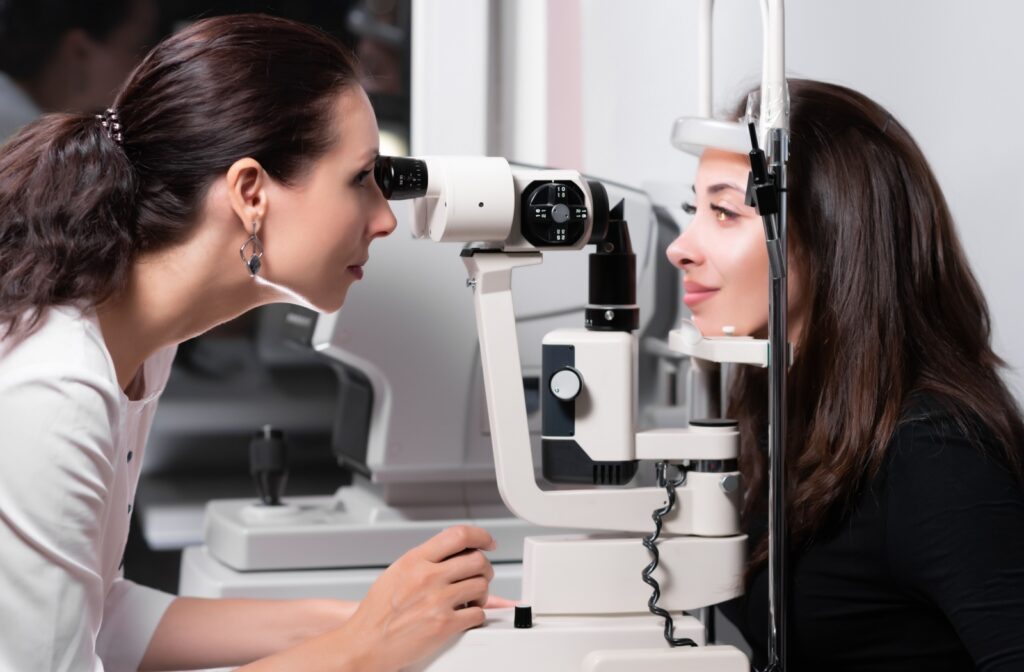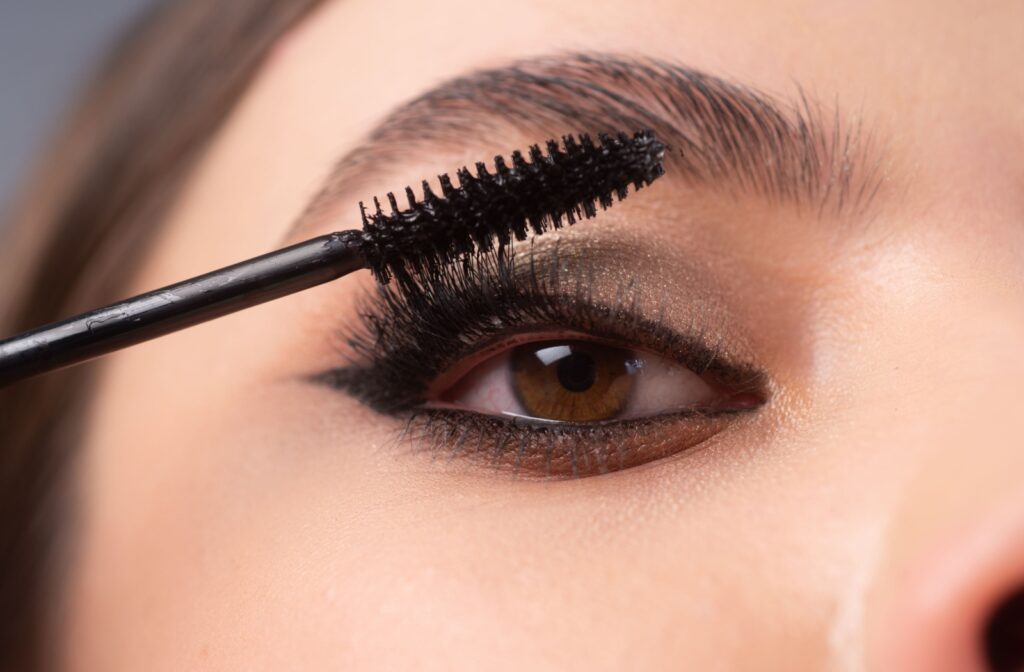Eye makeup and eye care share certain similarities. After all, healthy eyes are beautiful eyes. And, like many aspects of self-care, there are do’s and don’ts to keep in mind with vision care.
Sometimes, however, makeup routines and vision care can overlap. One such case is when you have punctal plugs.
You can wear punctal plugs with makeup, you just need to let the plugs settle for the first 24 hours. Afterwards, you can continue your routine. Just be sure to use gentle products and proper techniques to keep your eyes comfortable and prevent irritation from makeup flakes or debris.
Dry Eye & Eye Makeup
Enhancing your natural beauty with bold mascara or shimmery shadow might be a daily ritual, but it can also affect your eye health. Eye irritation or infection might come to mind, but we’d like to focus on a more chronic and pesky problem: dry eye.
Dry eye happens when your eyes don’t produce enough tears or when the quality of your tears isn’t sufficient to keep your eyes comfortable. This can lead to stinging, redness, blurry vision, and that pesky gritty sensation in your eye.
Does Eye Makeup Contribute to Dry Eye?
Yes, it can. Makeup, after all, varies in quality and ingredients. Poor-quality cosmetics or older products might contain ingredients that irritate your eyes or clog the oil glands in your eyelids.
- Glittery or shimmery eyeshadows: Small particles can flake into your eyes and cause irritation.
- Waterproof mascara: Though it’s long-lasting, waterproof mascara can be difficult to remove. Rubbing your eyes to remove makeup can lead to friction that strains already dry eyes.
- Old products: Expired or improperly stored makeup can harbor bacteria, leading to infections and further irritation.
But don’t pack your makeup away just yet! Being mindful of the products you use and how you apply them can make a big difference.
- Look for hypoallergenic, professionally-tested formulas: These are less likely to irritate your eyes.
- Avoid applying products close to your waterline: This can block your tear flow and further aggravate dryness.
- Use clean brushes and replace makeup regularly: Avoid bacteria buildup by keeping your tools sanitized and tossing out mascara every three months.
- Opt for cream-based products: These are less likely to flake than powders.
If, even after making these adjustments, your dry eye symptoms persist, it might be time to explore in-office treatments.
What Are Punctal Plugs?
If you’re familiar with dry eye therapies, many at-home remedies focus on replenishing the eyes with artificial tears or restoring the tear film with warm compress masks. While they can help, if you’re battling moderate dry eye, targeted therapies, like punctal plugs, are worth exploring.
Punctual plugs are tiny devices that we insert into the tear ducts (called puncta) to help your eyes retain moisture. The plugs prevent tears from draining, letting them stay on the eye’s surface a longer, which reduces irritation and dryness.
Punctal plugs are usually made of silicone or collagen. They’re comfortable and non-invasive, and we can insert them during a quick in-office procedure. Once inserted, they’re barely visible.
Temporary punctal plugs dissolve over time, while permanent ones can stay in place for months or even years, depending on your needs. A dry eye consultation helps determine which design is right for you.

Are Eye Makeup & Punctal Plugs Compatible?
Eye makeup and punctual plugs are compatible. However, once we insert the plugs, you should give your eyes a break from our makeup routine (at least 24 hours) and let the plugs settle in comfortably.
After that, you’re free to wear the makeup you love. Just be sure to use gentle products and follow proper hygiene practices to keep your eyes safe.
On the day of your appointment, it’s best to arrive makeup-free. We don’t want makeup flakes or debris getting into and irritating your eyes during the procedure. If that’s not possible, don’t sweat it! We’re happy to supply gentle, fragrance-free makeup remover for those who need it.
If you experience unusual irritation or discomfort after wearing makeup, pay us a visit to make sure your plugs are functioning as they should.
Exploring Alternative Dry Eye Therapies
Punctal plugs can be a great solution for many people, but others might benefit from a more comprehensive approach to dry eye therapy. Combining other effective options with punctual plugs can help address persistent dry eye symptoms, offering soothing comfort that lasts.
Here’s a closer look at the alternative treatments we offer:
- Prescription Eye Drops: Artificial tears can bring instant relief for mild cases, but prescription eye drops such as Restasis or Xiidra can help reduce inflammation and improve tear production.
- Nutritional Supplements: Omega-3 fatty acids, found in fish oil or flaxseed oil, can promote healthier tears.
- Warm Compress Mask: Placing a warm compress over your eyelids and gently massaging the area around your eyes with your fingers helps stimulate oil glands along the eyelids, restoring oil flow, and improving tear stability.
- Home Remedies: Simple changes, like using a humidifier, wearing wraparound sunglasses outdoors, and taking screen breaks, can complement other dry eye treatments effectively.
Eye Health & Beauty, Side by Side
Supporting your eye health doesn’t mean putting aside your makeup brush or mascara. With the right products and techniques, you can continue to wear makeup, with or without punctal plugs.
If dry eyes consistently hold you back, it’s time to explore dry eye therapies like punctal plugs. Though small, they’re an effective way to keep your eyes moist and comfortable. When we combine them with other treatments, you can find relief that lasts.
Take the first step toward healthier, happier eyes and book a dry eye consultation with Santa Cruz Optometric Center.



